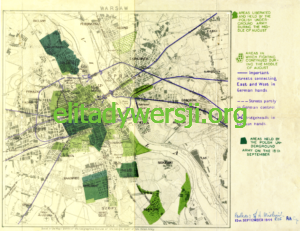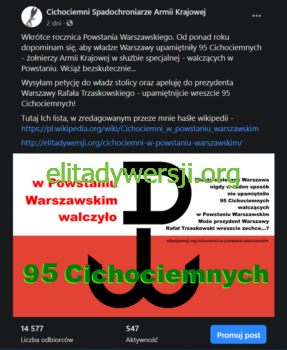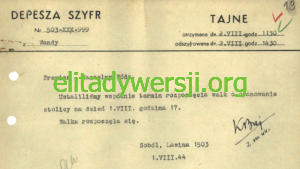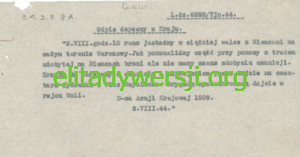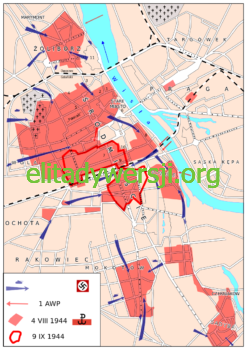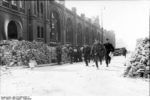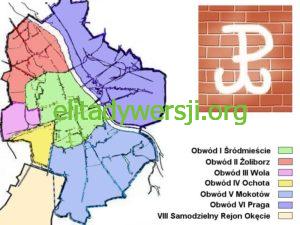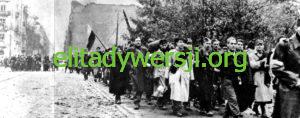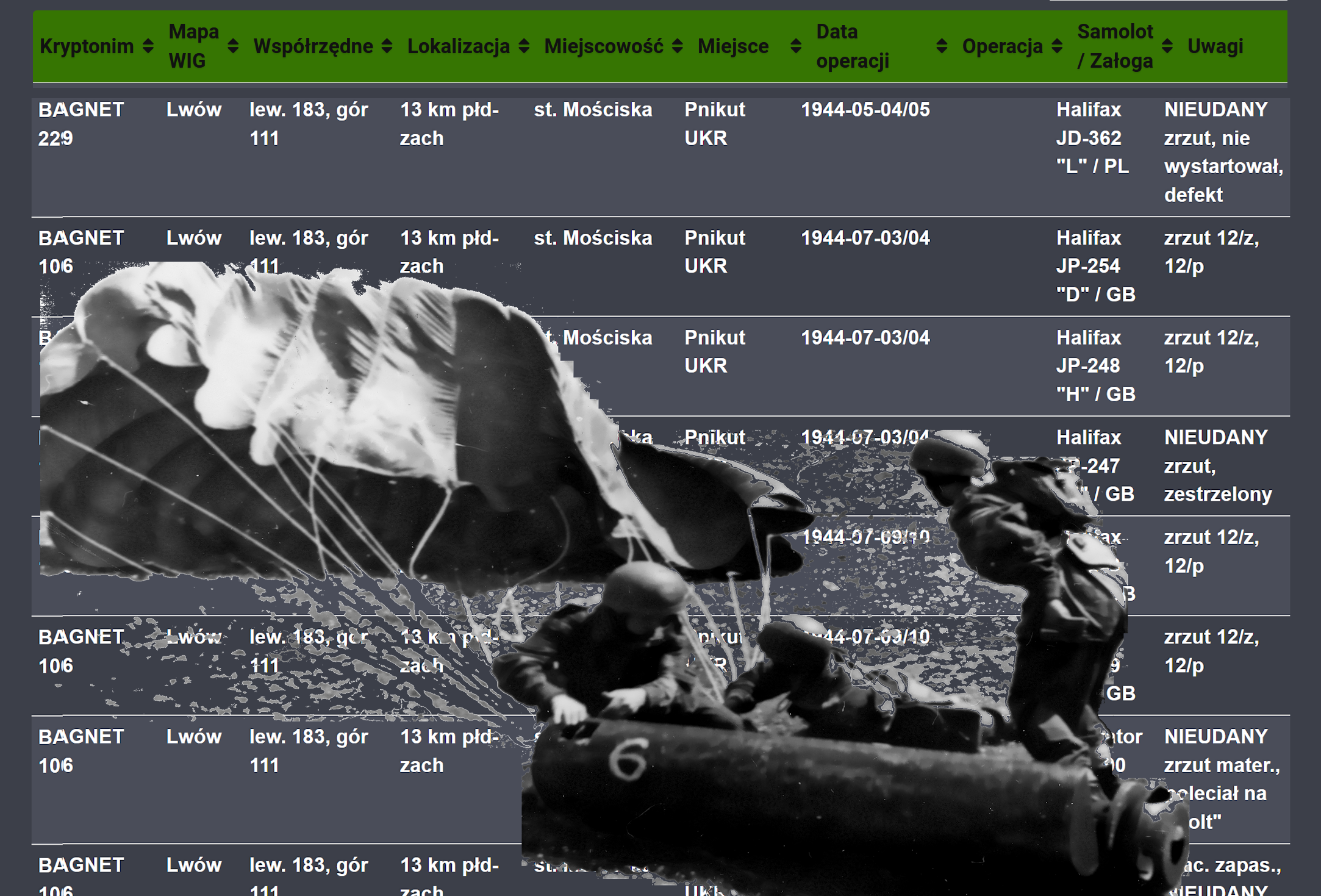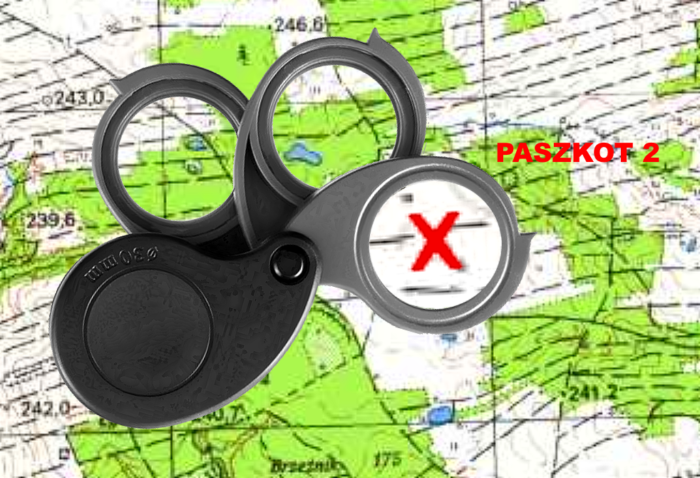Powstanie Warszawskie
- Wstęp
- Cichociemni w Powstaniu Warszawskim
- Okoliczności rozpoczęcia Powstania Warszawskiego
- Przebieg Powstania
- Broń w Powstaniu Warszawskim
- Rola kanałów warszawskich
- Łączność radiowa Sztabu Naczelnego Wodza
- Pomoc z Zachodu w pierwszych dniach Powstania
- Amerykański zrzut lotniczy na powstańczą Warszawę 18 września 1944
- Kontakty z ZSRR i PKWN
- Akt kapitulacji
- Spór o Powstanie Warszawskie
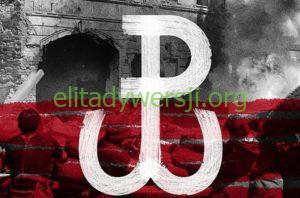 Powstanie Warszawskie (eng. Warsaw Uprising) było zorganizowanym przez Armię Krajową zbrojnym wystąpieniem przeciwko okupującym Warszawę Niemcom. Trwało od 1 sierpnia do 3 października 1944.
Powstanie Warszawskie (eng. Warsaw Uprising) było zorganizowanym przez Armię Krajową zbrojnym wystąpieniem przeciwko okupującym Warszawę Niemcom. Trwało od 1 sierpnia do 3 października 1944.
Walczyło w nim, według różnych źródeł, ok. 50 tys. żołnierzy, głównie Armii Krajowej, a także: Narodowych Sił Zbrojnych (740 – 3,5 tys.), formacji komunistycznych: Armii Ludowej i Związku Walki Młodych (270 – 800), Korpusu Bezpieczeństwa (600 – 700), Polskiej Armii Ludowej (120 – 500).
W Powstaniu walczyło także kilkuset obcokrajowców z ok. 17 krajów. Wszystkie formacje zbrojne były podporządkowane taktycznie dowództwu Armii Krajowej.
Cichociemni w Powstaniu Warszawskim
W Powstaniu Warszawskim walczyło 95 Cichociemnych – żołnierzy Armii Krajowej w służbie specjalnej
Spośród dziewięciu osób z dowództwa Powstania Warszawskiego, dwóch było Cichociemnymi: gen. Leopold Okulicki ps. Kobra, I zastępca szefa sztabu Komendy Głównej Armii Krajowej oraz płk. Kazimierz Iranek – Osmecki ps. Heller, szef Oddziału II (wywiad) Komendy Głównej Armii Krajowej.
Ponadto siedmiu Cichociemnych było w składzie Komendy Głównej Armii Krajowej (I rzut), pięciu Cichociemnych w składzie KG AK (II rzut) oraz dwóch Cichociemnych w dowództwie oddziału łączności nr 39 / osłonowego KG AK. Cichociemni pełnili funkcje dowódcze w oddziałach Armii Krajowej, walczyli w wywiadzie AK oraz zapewniali łączność, pracując na wszystkich radiostacjach Powstania Warszawskiego, o kryptonimach: Wanda 1, 2, 3, 4, 7, 9, 13, 23, 23A.
Ryszard M. Zając – Cichociemni w Powstaniu Warszawskim
w: Biuletyn Informacyjny AK nr 6 (410) czerwiec 2024, s. 15-23
Zobacz wykaz Cichociemnych uczestniczących w Powstaniu Warszawskim (wraz z Ich przydziałem) a także wykaz zrzutów materiałowych z zaopatrzeniem dla Powstania.
Opowieść o mieście – film ze zbiorów Instytutu Polskiego i Muzeum im. gen. Sikorskiego (SIK 029)
Okoliczności rozpoczęcia Powstania Warszawskiego
Powstanie Warszawskie nie było realizacją koncepcji powstania powszechnego lecz elementem odrębnej operacji Armii Krajowej nazwanej Akcją Burza. Było największą bitwą Armii Krajowej oraz największą bitwą Cichociemnych – żołnierzy Armii Krajowej w służbie specjalnej. Było także największą konspiracyjną akcją zbrojną przeciwko Niemcom w okupowanej przez nich Europie.
Zbigniew S. Siemaszko – Okoliczności rozpoczęcia Powstania Warszawskiego
w: Zeszyty Historyczne, Instytut Literacki Paryż 1985, zeszyt 72, s. 159-176
Waldemar Grabowski – Pierwsza depesza powstańczej Warszawy
w: Biuletyn IPN nr 7-8 (164-165), lipiec – sierpień 2019
Przebieg Powstania
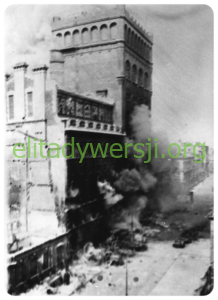
Płonący gmach PAST-y podczas powstania, plik NAC
Zasadniczym celem Powstania było wyzwolenie stolicy bezpośrednio przed wkroczeniem sowieckiej Armii Czerwonej, co miało powstrzymać lub utrudnić proces sowietyzacji Polski. Ten strategiczny cel nie został osiągnięty, po 63 dniach walk Armia Krajowa podpisała akt kapitulacji stolicy.
Przed wybuchem Powstania, 29 i 30 lipca 1944 sowieckie radio „Moskwa” i radiostacja „Kościuszko” wzywały mieszkańców Warszawy do walki z Niemcami, do wspólnego wyzwolenia Warszawy.
Po wybuchu Powstania Warszawskiego, sowiecka Armia Czerwona wstrzymała ofensywę, wojska sowieckie po drugiej stronie Wisły bezczynnie czekały aż Powstanie upadnie.
Sowiecki dyktator Józef Stalin zakazał udzielenia Powstaniu jakiejkolwiek pomocy. Ograniczone wsparcie, z dużym opóźnieniem udzielone Powstańcom przez USA oraz Wielką Brytanię, nie miało większego znaczenia, nie wpłynęło istotnie na sytuację militarną Powstania.
Tadeusz M. Płużański – Powstanie Warszawskie
– największy niepodległościowy zryw Armii Krajowej
i największa akcja zbrojna podziemia
w okupowanej przez hitlerowców Europie
w: Biuletyn Informacyjny AK lipiec – sierpień 2006, s. 9 – 13
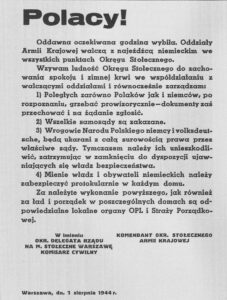 Powstanie rozpoczęło się o godzinie „W” (kryptonim dnia i godziny), tj. 1 sierpnia 1944 o godz. 17.oo. Powstańcze oddziały Okręgu Warszawa AK oraz oddziały dyspozycyjne Komendy Głównej AK zaatakowały Niemców we wszystkich dzielnicach stolicy Polski. Błędy w mobilizacji żołnierzy, a także organizacji akcji powstańczej (m.in. braki uzbrojenia), rozproszenie sił oraz brak efektu zaskoczenia (Niemcy zarządzili alarm dla garnizonu pół godziny wcześniej) spowodowały mniejsze sukcesy Powstańców.
Powstanie rozpoczęło się o godzinie „W” (kryptonim dnia i godziny), tj. 1 sierpnia 1944 o godz. 17.oo. Powstańcze oddziały Okręgu Warszawa AK oraz oddziały dyspozycyjne Komendy Głównej AK zaatakowały Niemców we wszystkich dzielnicach stolicy Polski. Błędy w mobilizacji żołnierzy, a także organizacji akcji powstańczej (m.in. braki uzbrojenia), rozproszenie sił oraz brak efektu zaskoczenia (Niemcy zarządzili alarm dla garnizonu pół godziny wcześniej) spowodowały mniejsze sukcesy Powstańców.
Opanowano znaczną część lewobrzeżnej Warszawy, w tym prawie całe Śródmieście i Stare Miasto. Nie powiodły się próby przejęcia głównych arterii komunikacyjnych Warszawy oraz przepraw na Wiśle.
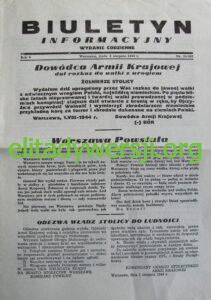 Powstanie miało trwać ok. 14 – trwało aż 63 dni. Niemcy wykorzystując swoją przewagę stopniowo odzyskiwali kontrolę nad miastem, dopuszczając się w kolejnych dzielnicach bestialskiego mordowania cywilnych mieszkańców stolicy. Od 4 do 7 sierpnia wymordowali ponad 30 tys. mieszkańców Woli. Do 11 sierpnia przejęli Ochotę, mordując kilkanaście tysięcy jej mieszkańców. Do końca sierpnia trwały krwawe starcia na Starym Mieście, Niemcy objęli je 2 września, rozpoczynając kolejną rzeź mieszkańców. Żołnierze oddziałów powstańczych zmuszeni zostali do przejścia kanałami do Śródmieścia oraz na Żoliborz. 6 września Niemcy zdobyli Powiśle, 13 września wysadzili mosty na Wiśle. Po zaciętych walkach zdobyli Czerniaków 24 września. Cztery dni wcześniej Powstańcy kanałami przeszli na Mokotów. 27 września Powstańcy z Mokotowa skapitulowali, część z nich kanałami przeszła na Śródmieście. 30 września skapitulował Żoliborz trwały ostatnie walki w Śródmieściu. W nocy 2/3 października 1944 przedstawiciele dowództwa Armii Krajowej podpisali akt kapitulacji. Ok. 15 tys. żołnierzy AK wzięto do niewoli.
Powstanie miało trwać ok. 14 – trwało aż 63 dni. Niemcy wykorzystując swoją przewagę stopniowo odzyskiwali kontrolę nad miastem, dopuszczając się w kolejnych dzielnicach bestialskiego mordowania cywilnych mieszkańców stolicy. Od 4 do 7 sierpnia wymordowali ponad 30 tys. mieszkańców Woli. Do 11 sierpnia przejęli Ochotę, mordując kilkanaście tysięcy jej mieszkańców. Do końca sierpnia trwały krwawe starcia na Starym Mieście, Niemcy objęli je 2 września, rozpoczynając kolejną rzeź mieszkańców. Żołnierze oddziałów powstańczych zmuszeni zostali do przejścia kanałami do Śródmieścia oraz na Żoliborz. 6 września Niemcy zdobyli Powiśle, 13 września wysadzili mosty na Wiśle. Po zaciętych walkach zdobyli Czerniaków 24 września. Cztery dni wcześniej Powstańcy kanałami przeszli na Mokotów. 27 września Powstańcy z Mokotowa skapitulowali, część z nich kanałami przeszła na Śródmieście. 30 września skapitulował Żoliborz trwały ostatnie walki w Śródmieściu. W nocy 2/3 października 1944 przedstawiciele dowództwa Armii Krajowej podpisali akt kapitulacji. Ok. 15 tys. żołnierzy AK wzięto do niewoli.
Najważniejsze depesze i dokumenty Powstania Warszawskiego
Broń w Powstaniu Warszawskim
(oprac. KJW) Grzegorz Jasiński – Broń w Powstaniu Warszawskim
w: Biuletyn informacyjny AK nr 08 (340) sierpień 2018, s. 15 – 26
Rola kanałów warszawskich
Aleksander Dobraczyński – Kanały warszawskie. Ich rola podczas Powstania Warszawskiego 1944 r.
w: Koło Byłych Żołnierzy AK – Oddział Londyn, polishresistance-ak.org
Łączność radiowa Sztabu Naczelnego Wodza
Zbigniew S. Siemaszko – Łączność radiowa Sztabu N.W. w przededniu Powstania Warszawskiego
w: Instytut Literacki Paryż, 1964, Zeszyty Historyczne nr. 6, s. 64 – 116
Pomoc z Zachodu w pierwszych dniach Powstania
Kajetan Bieniecki – Jak rzeczywiście wyglądała pomoc z Zachodu
dla Warszawy w pierwszych dniach Powstania
w: Zeszyty Historyczne, Instytut Literacki Paryż 1988, zeszyt 85, s. 47-67
Amerykański zrzut lotniczy na powstańczą Warszawę 18 września 1944
Andrzej Paweł Przemyski – Amerykański zrzut lotniczy na powstańczą Warszawę
18 września 1944: kontrowersje – fakty
w: Rocznik Lubelski 1985-1986, nr 27-28, s. 177-187
Kontakty z ZSRR i PKWN
Zbigniew S. Siemaszko – Powstanie Warszawskie – kontakty z ZSRR i PKWN
w: Zeszyty Historyczne, Instytut Literacki Paryż 1969, zeszyt 16, s. 5-66
Akt kapitulacji Powstania
Depesza dowództwa AK z treścią aktu kapitulacji
źródło: Studium Polski Podziemnej w Londynie
Spór o Powstanie Warszawskie
Podczas Powstania Warszawskiego poległo ok. 16 tys. żołnierzy, 20 tys. zostało rannych, 15 tys. wzięto do niewoli. Spośród 95 Cichociemnych uczestniczących w Powstaniu Warszawskim, co najmniej 20 było rannych lub ciężko rannych (niektórzy kilkakrotnie), 18 poległo w walce lub z powodu odniesionych ran.
W trakcie Powstania Warszawskiego, wskutek nalotów, ostrzału artyleryjskiego, zbrodni niemieckich – masowych mordów ludności cywilnej, a także z powodu bardzo ciężkich warunków bytowych zginęło ok. 150 – 200 tys. cywilnych mieszkańców Warszawy.
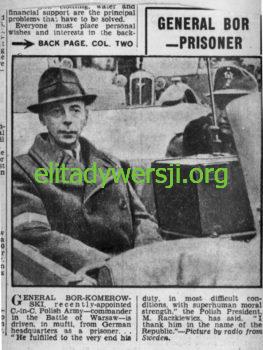 Według historyków, oprócz poległych w wyniku walk, co najmniej 63 tys. Warszawiaków straciło życie wskutek niemieckich zbrodni. Ze stolicy wypędzono ok. 550 tys. Warszawiaków, wypędzono także ok. 100 tys. mieszkańców miejscowości podwarszawskich. Spośród nich ok. 150 tys. osób wywieziono na przymusowe roboty do Niemiec. Straty Warszawy były ogromne.
Według historyków, oprócz poległych w wyniku walk, co najmniej 63 tys. Warszawiaków straciło życie wskutek niemieckich zbrodni. Ze stolicy wypędzono ok. 550 tys. Warszawiaków, wypędzono także ok. 100 tys. mieszkańców miejscowości podwarszawskich. Spośród nich ok. 150 tys. osób wywieziono na przymusowe roboty do Niemiec. Straty Warszawy były ogromne.
Decyzja dowództwa Armii Krajowej o wybuchu Powstania Warszawskiego miała charakter polityczny. Do dzisiaj budzi spore kontrowersje, głównie z powodu bardzo wysokich strat wśród ludności cywilnej oraz planowego wyburzania Warszawy przez Niemców. Dowództwo Armii Krajowej nie miało jednak żadnej realnej możliwości przewidzenia takiego zbrodniczego zachowania Niemców…
W trakcie walk powstańczych zniszczeniu uległo ok. 25 proc. zabudowy stolicy po lewej stronie Wisły, w tym prawie 100 proc. Starego Miasta. Znaczna część tych zniszczeń spowodowana była celowym podpalaniem całych kwartałów domów przez Niemców, na rozkaz naczelnego dowództwa. Ponadto od października 1944 do stycznia 1945 Niemcy wyburzyli ok. 30 proc. przedwojennej zabudowy Warszawy.
Ogółem zniszczono ok. 65 proc. zabudowy przedwojennej Warszawy, w 1945 w stolicy zalegało 20 milionów metrów sześciennych gruzów. Armia Krajowa nie zrealizowała swojego strategicznego celu wyzwolenia stolicy Polski przed wkroczeniem Sowietów. Wszystkie te okoliczności wywołują kontrowersje i spory o celowość Powstania…
Paweł Ukielski – Spór o Powstanie Warszawskie
w: biuletyn IPN, sierpień-wrzesień 2009, nr 8-9 (103-104), s. 116-125
więcej info – Spór o Powstanie Warszawskie
Zobacz:
- Wikipedia – Powstanie Warszawskie
- Wikipedia – Warsaw Uprising (eng)
- Cichociemni w Powstaniu Warszawskim
- Wikipedia – Cichociemni w Powstaniu Warszawskim
- Powstanie Warszawskie – produkcja broni i amunicji
- Wikipedia – Zbrodnie niemieckie w Powstaniu Warszawskim
- Wikipedia – Zburzenie Warszawy
- Wikipedia – Siły polskie w Powstaniu Warszawskim
- Wikipedia –Siły niemieckie w Powstaniu Warszawskim
- Wikipedia – Powstanie powszechne
- Wikipedia – Akcja Burza
- Instytut Pamięci Narodowej – Powstanie Warszawskie – bój o wolną Polskę
- Wojsko Polskie – Powstanie Warszawskie
- Muzeum Powstania Warszawskiego – Powstanie Warszawskie
- Stowarzyszenie Pamięci Powstania Warszawskiego – Krótka historia Powstania Warszawskiego 1944
Tł..

